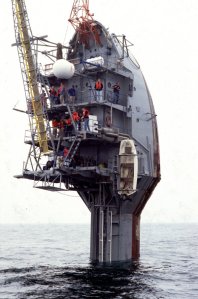One of the hashtags often used by the U.S. Navy in their various social media feeds is #PlatformsMatter. The term now frequently pops into my head while I’m doing research – a 21st century mantra for the marine historian. The importance of engineering and design for marine work is something I’ve thought about with respect to oceanographic platforms. For historians specializing in the study of a particular branch of science there is always the risk of focusing too narrowly on technological developments related to one area of study while ignoring developments in related fields. It is helpful to remember that, in a fashion similar to the process of biological natural selection, environmental characteristics and constraints help determine the “evolution” of technology designed to function in particular environments. Thus, we now find similar design elements across various types of marine platforms.
Perhaps the most challenging environmental characteristic of the ocean is the constant motion – as anybody who’s ever experienced seasickness will undoubtedly attest. A naval engineer trying to figure out how to aim a battleship’s guns on a rolling vessel and a marine chemist trying to stabilize a sand bath aboard a research vessel are faced with the same environmental problem. Thus, both the oceanographer and the naval officer want a stable platform for their work at sea. It should come as no surprise then that if we trace back the history of various marine technologies we will find earlier technologies with hybrid characteristics – common ancestors of today’s marine platforms.


Let me give you an example. Around 1877, an Italian engineer named Donato Tommasi, then residing in Paris, proposed a design for a vessel that he named the “Hémi-Plongeur.” The vessel, as the name suggests, combined double submerged hulls with a circular platform held above the water by support towers. While I’ve found no evidence that this craft was ever built, it did excite a great deal of enthusiasm in the popular press. As Tommasi explained in a French journal, not only would the vessel be more stable and more comfortable for passengers, it would also be more efficient traveling through the water. The submerged hulls would be less affected by surface swell than a normal ship, and might even take greater advantage of passive transport on ocean currents (which might now be mapped in greater detail). In case of accident – a fire in the submerged engine room, for instance – the top platform could detach and become a life raft. Furthermore, the vessel could easily be modified for military use. The stable platform would allow easier targeting for the guns, and the submerged hull, acting like a submarine, could be flooded to lower the platform and reduce the surface area vulnerable to enemy fire. (Though the Hémi-Plongeur was never built, in 1873 the Imperial Russian Navy did launch at least two circular warships. However, instead of increasing stability, the circular hulls made these vessels difficult to maneuver.)
Perhaps in this failed 19th century precedent we can see ancestral attributes of both the modern floating oil rig and floating oceanographic research platform – the most famous being of course Scripps’ FLIP platform. The Hémi-Plongeur was the ill-fated Neanderthal branch in our technological evolutionary tree. Platforms matter; and engineers designing platforms for various types of operations in the marine environment must all confront the same environmentally determined limitations.



[…] so too does it create difficulties for engineers, as Antony Adler discusses in his post “#PlatformsMatter: Design and the Marine Environment” on the History of […]